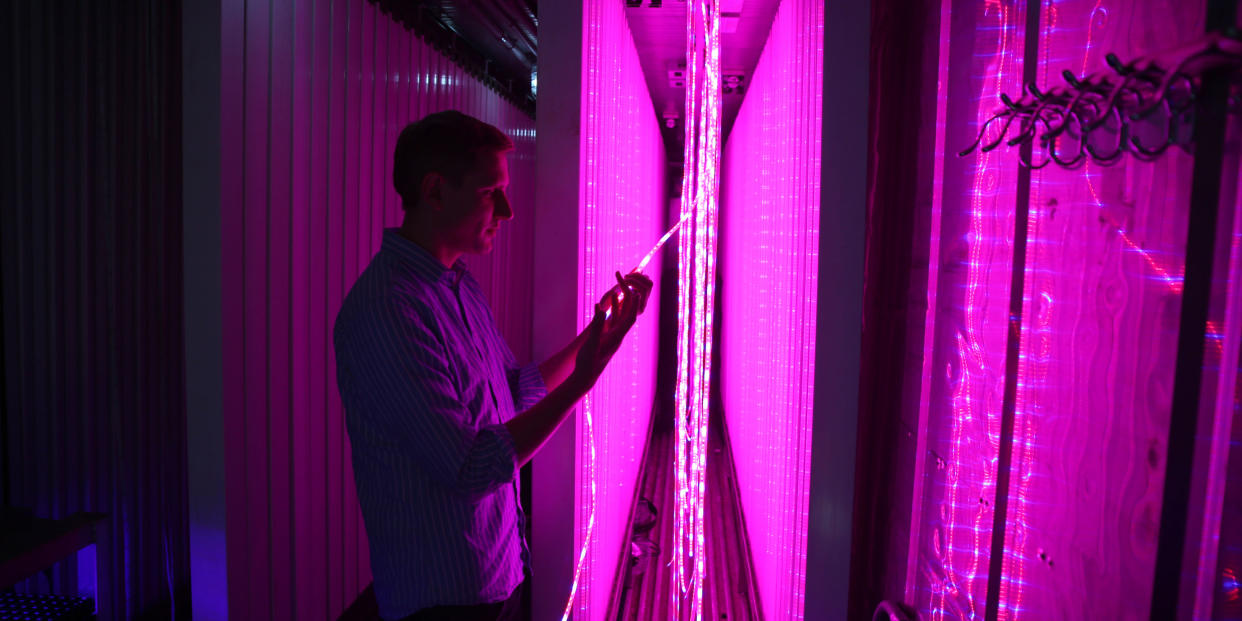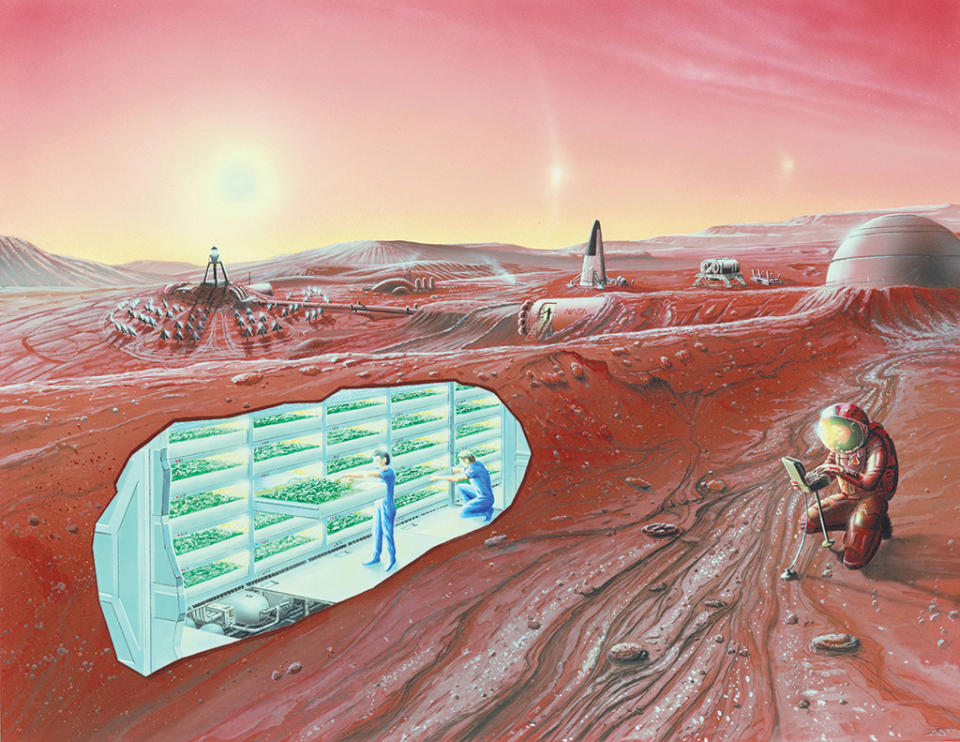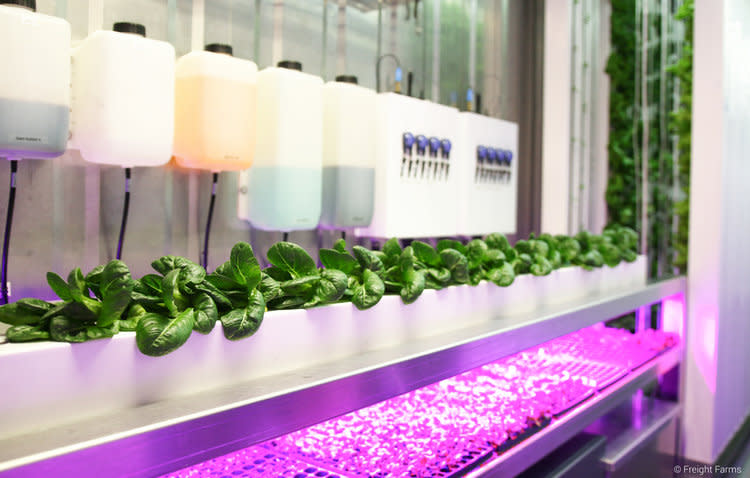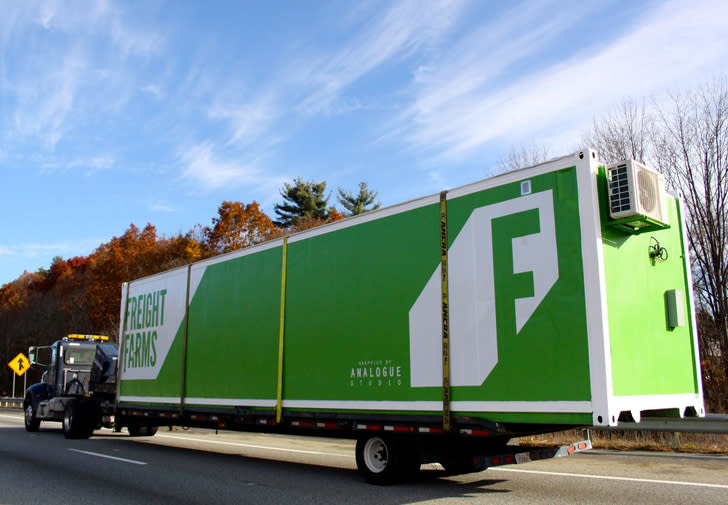Freight Farms Builds Farms in Shipping Containers, and NASA Wants to Launch Them to Space

If we built farms in space, they'd look nothing like the vast wheat fields of Kansas. But they just might look something like urban farms being used today-modular closed-loop hydroponic farms, actually. These compact, efficient grow houses could be the life-giving answer to keeping astronauts fed, a solution The Martian's Mark Watney could only dream of. The idea is less science fiction than you might think, too.
Freight Farms, based in Boston, is trying to revolutionize the global food system with its Leafy Green Machines. These shipping containers filled with racks of planted crops, grow lights, and environmental control systems can be installed anywhere in the world and make fresh produce available in even the densest urban neighborhoods.
Although Freight Farms initial intentions were much more down to Earth, the company inadvertently built a prototype farm that NASA wants to study for future applications on other planets. And NASA isn't the only one. Google and modern farming entrepreneurs including Kimbal Musk, brother to Martian hopeful Elon Musk, have also shown interest in the project.
A single Leafy Green Machine (LGM) can house the equivalent of roughly two acres of produce. One LGM can produce an astonishing 1,000 heads of restaurant-ready lettuce a week, and restaurants like B.Good in Boston are taking advantage of fresher, less expensive produce grown in their own backyard LGMs.
"The demand now is farm to table. It's all about local," co-founder Jon Friedman told Popular Mechanics. "Which is great for summer for select geographies, but for the rest of the year, that isn't possible." Boston winters have as little as 3 hours of daylight, and the massive snow load would ruin the delicate frames of most modular indoor farm prototypes. Friedman calls the shipping containers "magnificent structures for their thermal properties" as well as for their robust structural integrity and easy-to-manage unit size.
With this compelling proof-of-concept on Earth, Freight Farms and Clemson University recently received a grant from NASA to develop the next generation of off-the-grid systems using as many renewables as possible with an ultimate goal of providing "life support for human exploration of deep space." Future LGMs could be even more self-regulating as Freight Farms looks to incorporate technologies like water capture from the ambient air and automatic compost systems. Eventually, Freight Farms would like to build LGMs that are entirely autonomous and run on 100 percent renewable energy.

The NASA grant-under the agency's research initiative, "Closed-Loop Living System for Deep-Space ECLSS with Immediate Applications for a Sustainable Planet"-is designed to help Freight Farms advance their LGM technology to the point that the space agency could adapt the farms and launch them into space. In addition to providing food for astronauts, NASA wants to work with Freight Farms to study the production of proteins and medicines, develop lightweight containers with inflatable materials or 3D printing, and ultimately design a similar system to the LGM that could be incorporated into "space exploration vessels."
Freight Farms' largest customer on this planet, however, is Brooklyn-based Square Roots Grow, founded by Kimbal Musk and Tobias Peggs. Square Roots operates a whole parking lot full of LGM units for local growers and entrepreneurs. Because the containers are self-contained, they can program the simulated daytime hours inside the farms to run at night when energy costs are lower. It's a sustainable system that has legs.
"My hope is that we are in every metro area in America as fast as we can get there," Musk told Popular Mechanics in an email.

Beyond fresh greens, Freight Farm founders Jon Friedman and Brad McNamara say that it's also popular to grow radishes, edible flowers, peppers, tomatoes, and pumpkins. What's more, given the closed-loop system of a LGM, it can sustain the crops on just 10 gallons of water a day. The efficiencies of Leafy Green Machines are an astonishing 90 percent improvement over traditional farming, according to the USDA.
Maintaining a single LGM takes roughly 20 hours per week. That's only 10 hours per acre, per week. To sustain the plants, columns of hanging LED strips with blue and red diodes in the grow lights require an average of between 90 and 110 kWh per day-about the equivalent of 3 average U.S. households. Many LGMs are outfitted with solar panels as well to minimize the required energy input.
Freight Farms' LGMs are currently operating across America, Canada, Europe, and Japan. Atlantic island nations are among the first in the developing world do adopt the technology in an effort to become more food-independent. These areas are heavily reliant on imports, and even though they have tropical climates, food production is difficult. The result is high prices and low variety from imported produce. Pilot projects are currently sprouting up throughout the Middle East and Africa as well. And yes, the units can be shipped out on trucks, freighters, and railroads, traveling anywhere you can send an intermodal container-so basically anywhere in the world.

And it's not just restaurants or remote islands that have opted for the Leafy Green Machine. Institutions around America are harnessing the power of these units not only for food but also for educational purposes. Corporate campuses like Google were eager early adopters. Schools including the University of Michigan and UMass Dartmouth are using the LGMs as part of their curriculum to teach students about sustainable agriculture.
The benefit of distributed small farms is that they're vastly more sustainable than larger options in terms of conserving land and minimizing transport. Between production and shipping, the global food system accounts for about one-third of all human-induced greenhouse gas emissions. It also helps that the local produce passes through fewer hands, which means more affordable food. "The most exciting thing about Square Roots and urban farming is getting back to knowing our farmer and trusting our food again," says Musk.
With Leafy Green Machines spreading across the world, it might not be too long until NASA builds the very first variant-the Leafy Red Machine, perhaps?-and launches it to Mars.
You Might Also Like

